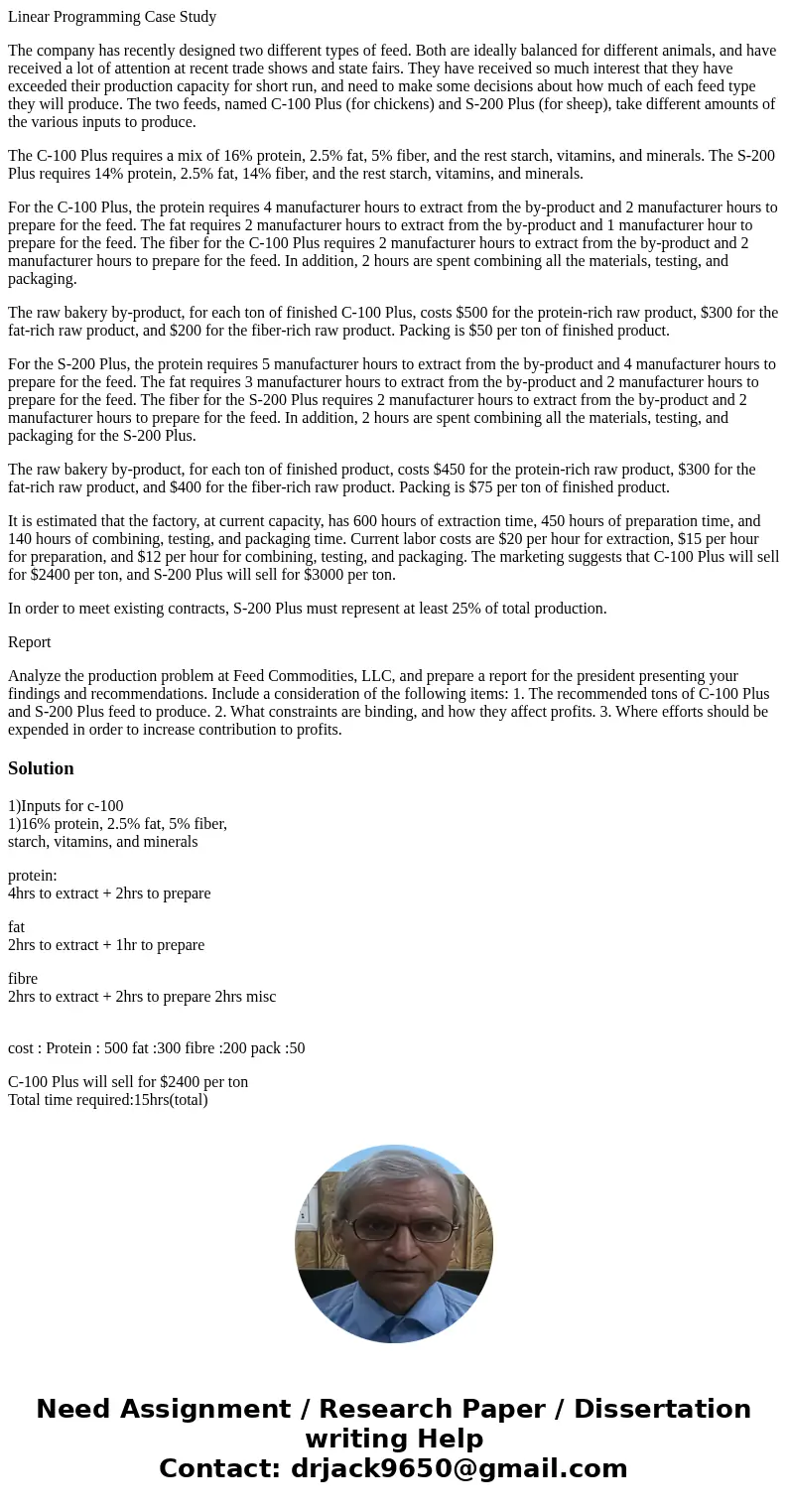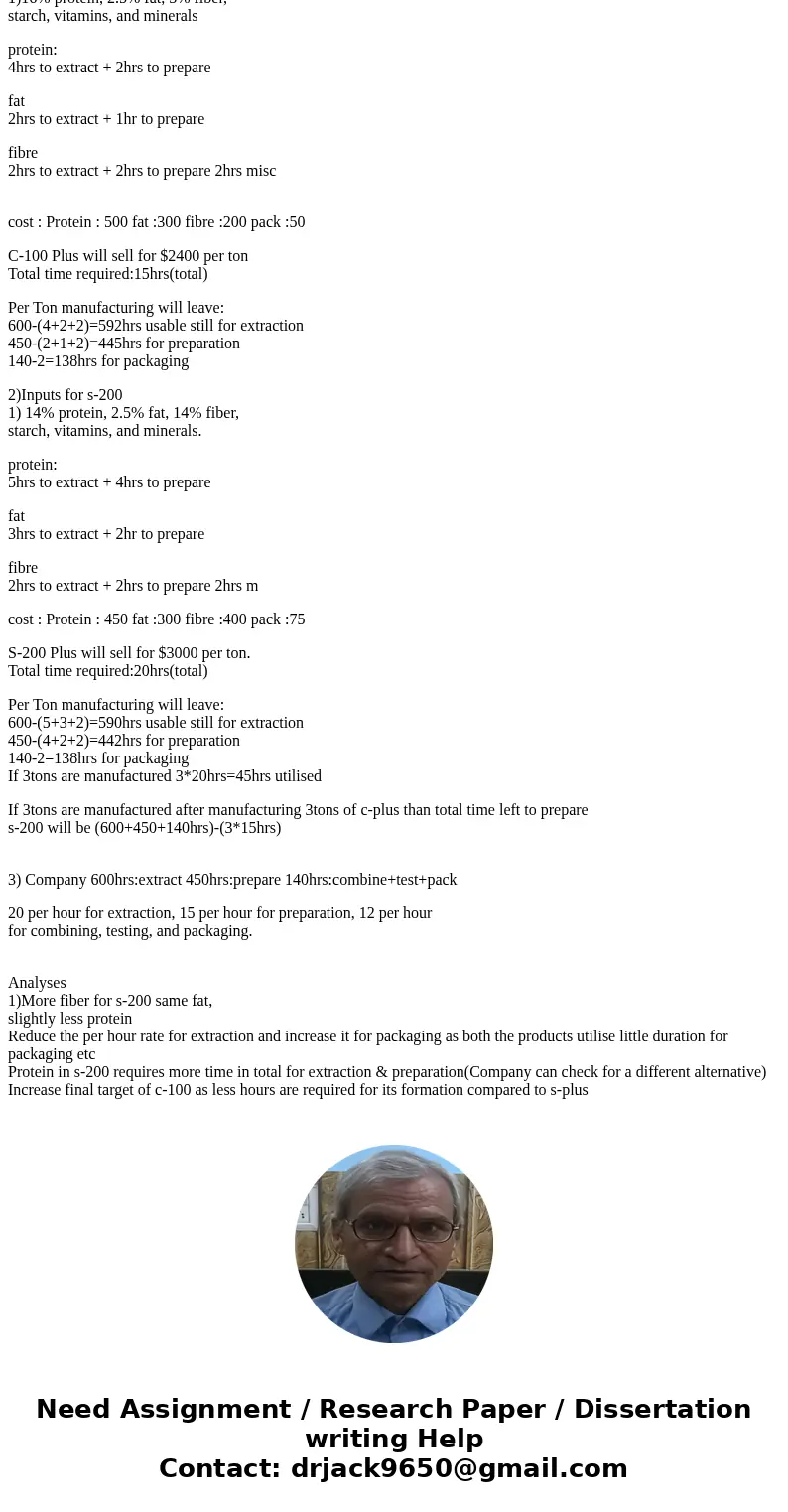Linear Programming Case Study The company has recently desig
Linear Programming Case Study
The company has recently designed two different types of feed. Both are ideally balanced for different animals, and have received a lot of attention at recent trade shows and state fairs. They have received so much interest that they have exceeded their production capacity for short run, and need to make some decisions about how much of each feed type they will produce. The two feeds, named C-100 Plus (for chickens) and S-200 Plus (for sheep), take different amounts of the various inputs to produce.
The C-100 Plus requires a mix of 16% protein, 2.5% fat, 5% fiber, and the rest starch, vitamins, and minerals. The S-200 Plus requires 14% protein, 2.5% fat, 14% fiber, and the rest starch, vitamins, and minerals.
For the C-100 Plus, the protein requires 4 manufacturer hours to extract from the by-product and 2 manufacturer hours to prepare for the feed. The fat requires 2 manufacturer hours to extract from the by-product and 1 manufacturer hour to prepare for the feed. The fiber for the C-100 Plus requires 2 manufacturer hours to extract from the by-product and 2 manufacturer hours to prepare for the feed. In addition, 2 hours are spent combining all the materials, testing, and packaging.
The raw bakery by-product, for each ton of finished C-100 Plus, costs $500 for the protein-rich raw product, $300 for the fat-rich raw product, and $200 for the fiber-rich raw product. Packing is $50 per ton of finished product.
For the S-200 Plus, the protein requires 5 manufacturer hours to extract from the by-product and 4 manufacturer hours to prepare for the feed. The fat requires 3 manufacturer hours to extract from the by-product and 2 manufacturer hours to prepare for the feed. The fiber for the S-200 Plus requires 2 manufacturer hours to extract from the by-product and 2 manufacturer hours to prepare for the feed. In addition, 2 hours are spent combining all the materials, testing, and packaging for the S-200 Plus.
The raw bakery by-product, for each ton of finished product, costs $450 for the protein-rich raw product, $300 for the fat-rich raw product, and $400 for the fiber-rich raw product. Packing is $75 per ton of finished product.
It is estimated that the factory, at current capacity, has 600 hours of extraction time, 450 hours of preparation time, and 140 hours of combining, testing, and packaging time. Current labor costs are $20 per hour for extraction, $15 per hour for preparation, and $12 per hour for combining, testing, and packaging. The marketing suggests that C-100 Plus will sell for $2400 per ton, and S-200 Plus will sell for $3000 per ton.
In order to meet existing contracts, S-200 Plus must represent at least 25% of total production.
Report
Analyze the production problem at Feed Commodities, LLC, and prepare a report for the president presenting your findings and recommendations. Include a consideration of the following items: 1. The recommended tons of C-100 Plus and S-200 Plus feed to produce. 2. What constraints are binding, and how they affect profits. 3. Where efforts should be expended in order to increase contribution to profits.
Solution
1)Inputs for c-100
1)16% protein, 2.5% fat, 5% fiber,
starch, vitamins, and minerals
protein:
4hrs to extract + 2hrs to prepare
fat
2hrs to extract + 1hr to prepare
fibre
2hrs to extract + 2hrs to prepare 2hrs misc
cost : Protein : 500 fat :300 fibre :200 pack :50
C-100 Plus will sell for $2400 per ton
Total time required:15hrs(total)
Per Ton manufacturing will leave:
600-(4+2+2)=592hrs usable still for extraction
450-(2+1+2)=445hrs for preparation
140-2=138hrs for packaging
2)Inputs for s-200
1) 14% protein, 2.5% fat, 14% fiber,
starch, vitamins, and minerals.
protein:
5hrs to extract + 4hrs to prepare
fat
3hrs to extract + 2hr to prepare
fibre
2hrs to extract + 2hrs to prepare 2hrs m
cost : Protein : 450 fat :300 fibre :400 pack :75
S-200 Plus will sell for $3000 per ton.
Total time required:20hrs(total)
Per Ton manufacturing will leave:
600-(5+3+2)=590hrs usable still for extraction
450-(4+2+2)=442hrs for preparation
140-2=138hrs for packaging
If 3tons are manufactured 3*20hrs=45hrs utilised
If 3tons are manufactured after manufacturing 3tons of c-plus than total time left to prepare
s-200 will be (600+450+140hrs)-(3*15hrs)
3) Company 600hrs:extract 450hrs:prepare 140hrs:combine+test+pack
20 per hour for extraction, 15 per hour for preparation, 12 per hour
for combining, testing, and packaging.
Analyses
1)More fiber for s-200 same fat,
slightly less protein
Reduce the per hour rate for extraction and increase it for packaging as both the products utilise little duration for packaging etc
Protein in s-200 requires more time in total for extraction & preparation(Company can check for a different alternative)
Increase final target of c-100 as less hours are required for its formation compared to s-plus


 Homework Sourse
Homework Sourse